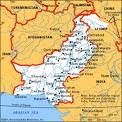Sufi Movement became dormant with the decline of Muslim power in India. With failure of armed resistance against the British and Sikh-Hindu combined, the followers of hard line Sufism were forced to adjust with the ground reality of non-Muslim occupation of Indian sub continent but did not reconcile with it. The failure of "Sepoy Mutiny" and consolidation of British power in Indian subcontinent was a further jolt on the radical Islamists but all the Islamic revivalists movements like Deoband, Aligarh, and Pakistan movement drew their inspirations from the anti-Hindu syndrome of Sufi saints like Sirhind and Shah Wal Ullah. Khilafat movement and subsequent Pakistan movement were the outcome of the jehadi interpretation of Walli Ullah brand of neo-Sufi jehad against the political domination of non-believers. The resistance of Muslims against the British and subsequently against the Indian National Congress was due to deep and hard line influence of Shah Wali Ullah over them.
Before the failure of 1857 Sepoy Mutiny Sir Sayed Ahmad Khan was a follower of the neo-Sufi cult of Shah Waliullah. But he gradually distanced himself and firmly rooted in the Indian islamic mysticism that he was deply pained after the collapse of Sepoy mutiny of 1857.He therefore took up the challenge of and wanted to take up the revolutionary path by educating the Muslims in European education but he did not distanced himself frm the Wali Ullah and bacame a supporter of Two Nation theory.His philosophy was a synthesis of progressive and orthodox Islam.
According to Allama Iqbal, he was the first Muslim to feel the urge for rethinking the whole system of Islam without, in any way, breaking away from the past.
Iqba was a known follower of Islamic mysticism of Quadirriyya order. He synthesised the mystin ideology of Wali Ullah and the modern view of Sir Sayed Ahmad Khan.
The concept of Tawhid (unity of God) on the basis of Sufiism was a tool of political conflict with the Hindus. Its apparent Secular ideas accepted by the hindus were not reciprocated by muslims.Had sufism, as commonly, been viewed as a secular attempt to adapt Islam in hindu tradition, the philosophy of two nation theory would not have been merged.













.jpg)






















.jpg)















